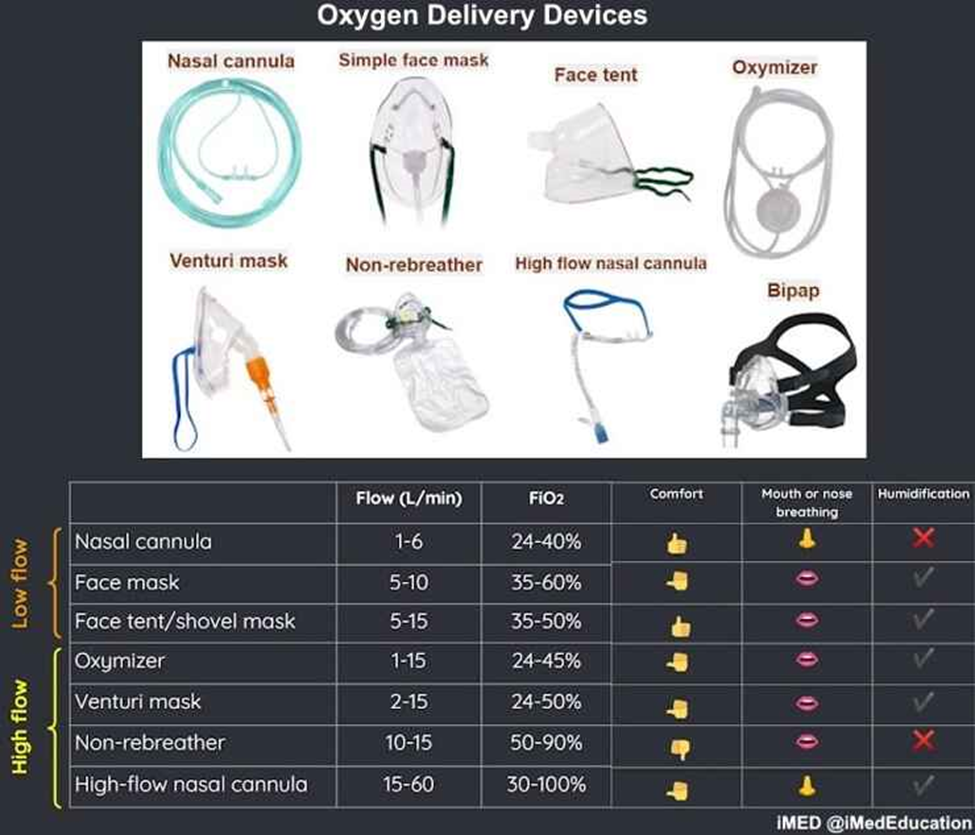The nurse is caring for a client who is experiencing mild shortness of breath during the immediate postoperative period, with oxygen saturation readings between 89% and 91%. What method of oxygen delivery is most appropriate for the client’s needs?
Partial non-rebreathing mask
Simple (Oxy Plus) mask
Nasal cannula
Non-rebreathing mask
The Correct Answer is C
A. Partial non-rebreathing mask:
This mask delivers higher concentrations of oxygen than a nasal cannula. It has a reservoir bag that allows the client to rebreathe some exhaled air, increasing the oxygen concentration delivered. However, it may not be necessary for a client with mild shortness of breath and slightly reduced oxygen saturation.
B. Simple (Oxy Plus) mask:
The simple mask provides a higher concentration of oxygen than a nasal cannula but lacks the reservoir bag found in the non-rebreathing mask. It is generally used for moderate oxygen needs. However, it might be more than what is required for a client with mild shortness of breath and slightly reduced oxygen saturation.
C. Nasal cannula:
Nasal cannulas are commonly used for clients with mild respiratory distress. They deliver a lower to moderate concentration of oxygen and are well-tolerated by most clients. They are suitable for individuals with mild shortness of breath and can be adjusted based on the required flow rate.
D. Non-rebreathing mask:
The non-rebreathing mask provides the highest concentration of oxygen among the options listed. It includes a reservoir bag to deliver a higher oxygen concentration. It is typically reserved for clients with higher oxygen requirements. For a client with mild shortness of breath and slightly reduced oxygen saturation, this may be more than necessary.

Nursing Test Bank
Naxlex Comprehensive Predictor Exams
Related Questions
Correct Answer is B
Explanation
A. Maintaining a diet high in dairy to increase protein necessary to prevent organ damage
Explanation: This statement is not accurate. While a balanced diet is important, there is no specific recommendation to maintain a diet high in dairy to prevent organ damage related to hypertension.
B. Use of strategies to prevent falls stemming from postural hypotension
Explanation: This is a correct and important consideration. Beta-blockers can cause postural hypotension (a drop in blood pressure upon standing), and strategies to prevent falls, such as rising slowly from a sitting or lying position, are crucial.
C. Limiting exercise to avoid injury that can be caused by increased intracranial pressure
Explanation: This statement is not accurate. Exercise is generally beneficial for individuals with hypertension, and beta-blockers do not cause increased intracranial pressure.
D. Increasing fluids to avoid extracellular volume depletion from the diuretic effects of the beta-blocker
Explanation: This statement is not accurate. Beta-blockers are not typically associated with diuretic effects. Diuretics are a different class of medications commonly used for hypertension.
Correct Answer is A
Explanation
A. "A single elevated blood pressure does not confirm hypertension. A diagnosis of hypertension requires two or more elevated readings taken by your physician before a diagnosis can be made."
This response emphasizes the need for multiple elevated readings for a diagnosis of hypertension. It educates the individual about the diagnostic criteria and encourages them to seek further evaluation from their physician.
B. "We will need to reevaluate your blood pressure because your age places you at high risk for hypertension."
This response might be seen as implying that age alone is a significant factor in determining hypertension, which may not be accurate. While age is a risk factor, the emphasis should be on the need for multiple readings and a physician's evaluation rather than attributing it solely to age.
C. "Hypertension is prevalent among men: it is fortunate we caught this during your routine examination."
This response suggests that the elevated blood pressure is automatically assumed to be hypertension based on gender. It is important to avoid making assumptions and instead focus on the need for proper evaluation and multiple readings for a hypertension diagnosis.
D. "You have no need to worry. Your pressure is probably elevated because you are being tested."
This response dismisses the individual's concerns and attributes the elevated blood pressure solely to the testing situation. While stress or anxiety can influence blood pressure readings, it's essential to address the need for further evaluation and not completely disregard the possibility of hypertension.
Whether you are a student looking to ace your exams or a practicing nurse seeking to enhance your expertise , our nursing education contents will empower you with the confidence and competence to make a difference in the lives of patients and become a respected leader in the healthcare field.
Visit Naxlex, invest in your future and unlock endless possibilities with our unparalleled nursing education contents today
Report Wrong Answer on the Current Question
Do you disagree with the answer? If yes, what is your expected answer? Explain.
Kindly be descriptive with the issue you are facing.
